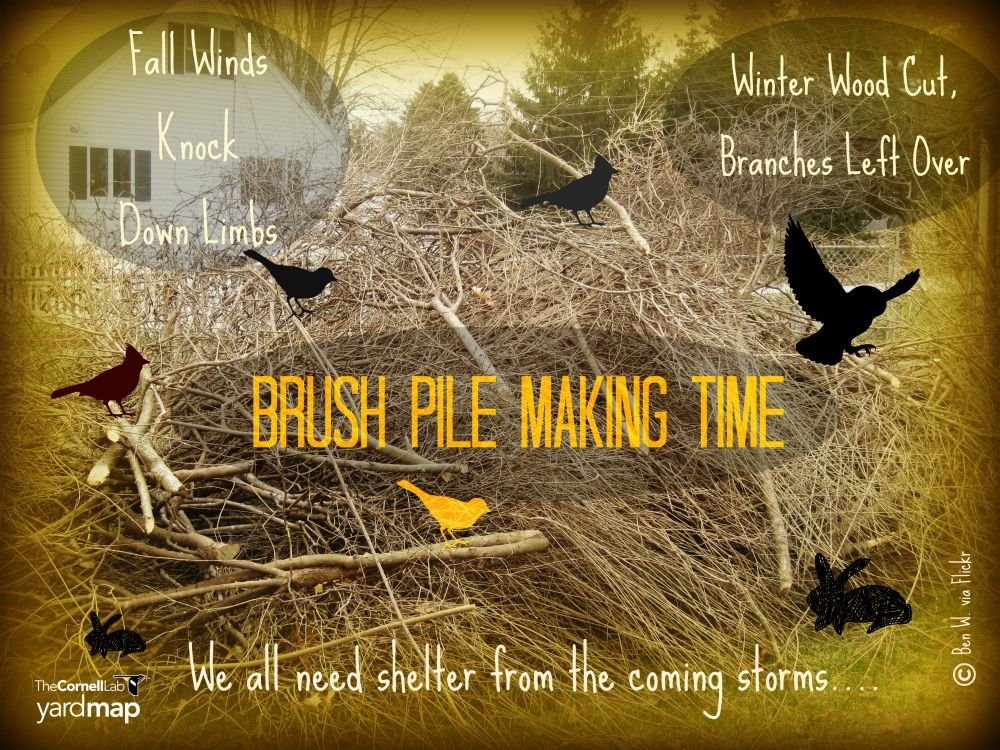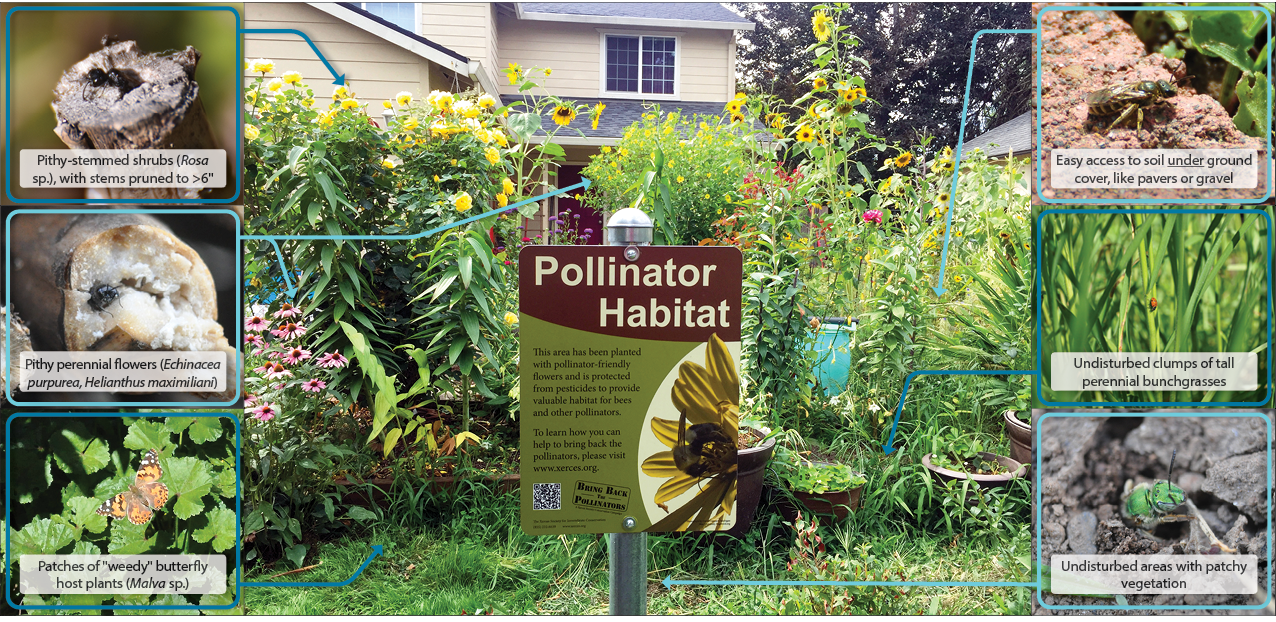PLANNING & PRUNING FOR WILDLIFE IN YOUR GARDEN
To prune or not to prune? There are varied opinions on the optimal timing for seasonal garden clean-up, often grounded in aesthetic concerns rather than taking into account the ecosystem that relies on the natural cycles unfolding within your yard. Don’t be in a rush to tidy up too much, a little bit of inattention can help provide a secure haven for indigenous pollinators and wildlife during the winter season. Read on to find out more about what warrants your attention, what can be ignored until the warmer weather returns and how you can do your part to help wildlife thrive in your garden!
Image credit: Xerces Society - Steven Severinghaus flickr cc
Many conservation experts encourage gardeners to bypass their urge to bag their yard waste and to “Leave the Leaves” to support pollinators. Leaving organic ground litter (leaves, stalks, stems, etc.) in place adds useful nutrients for plant health as it decomposes, protects from cold weather, helps retain moisture during dry seasons, suppresses weeds, and provides nesting materials for a wide variety of invertebrates. According to the Xerces Society for Invertebrate Conservation, “The availability of nesting and overwintering habitat is one of the most important factors influencing populations of native bees and other beneficial insects.”
Image courtesty of healthyyards.org
Creating Habitat
Here are some helpful tips to make sure your garden supports wildlife throughout the seasons!
Leave the Leaves! While it may be necessary to rake them from pathways and clear your lawn, please consider reusing them to mulch your garden beds and add them around trees and shrubs. Gathering them onto a tarp to spread them in useful areas is a quick way to get the job done and avoid any bagging.
Leave stalks, stems and seed heads in place until after the last frost, a good indication of when it is time to prune is when you start to see pollinators around and the temperatures are above 50 degrees. If you must prune, create a brush pile in a back corner with your fallen waste!
Leave dead or fallen trees in place (as long as they aren’t a safety hazard!) If it does pose an issue, consider relocating the wood to a back corner of your garden. This creates a “snag” and is a great resource for a variety of wildlife, including insects, lizards and many species of birds. Use any extra twigs or sticks to create your own “insect hotel” to add visual interest to your garden!
Vary the type of habitats around your garden, allowing bare ground, dry stacked rocks, multiple brush piles, and provide clean water sources. Many solitary and non-aggressive pollinators need bare ground to create their nests. Rocks and brush piles that provide crevices for shelter and fresh, shallow sources of drinking water are much needed to sustain wildlife through the winter.
Example of an insect hotel
Brush piles and snags provide homes for a variety of beneficial insects. This makes them a source of bird food, and for brush and cavity-nesters, a source of shelter as well. Brush piles in particular are magnets for small bird species and snags supply a steady source of sustenance for woodpeckers and other birds, raptors even use them for hunting and nesting perches!
Via CornellLab YardMap (image credit: Ben W. via Flickr)
When it comes to water, bird baths may be your first thought. But if your space is limited, you may be able to make do with something even smaller—such as a puddling station for bees and butterflies. Ponds and rain gardens can also provide water for wildlife, many people use non-toxic mosquito dunks to prevent infestation without causing any harm to other creatures.
Example of butterfly & bee puddling station
Planting and Pruning for Wildlife
Keystone plants are a great place to start when deciding what to include in your garden, they include shrubs that flower or provide fruit or seeds—such as blueberry bushes or black-eyed Susans, and host hundreds of species of butterflies and bees. These plants are deemed essential in upholding the food web, planting these species and familiarizing yourself with Florida Friendly Landscaping practices will allow you to be miles ahead in your journey to create a true wildlife sanctuary!
Native perennials are also key to any successful wildlife garden and require minimal upkeep, although they can end up looking long and leggy in the dormant season. If you can’t resist the urge to prune prior to Spring, we totally understand but would recommend using the following guidelines to mitigate the damage that can be caused:
For dormant perennials and other flowering plants, cut the stalks back and stash the waste in a hidden area in the back corner of your garden, they can still be used by pollinators or added to your compost.
Cut stalks down to between 8-24 inches from the base of the plant. This creates vertical nesting sites in an array of heights and widths to suit a variety of insects and pollinators.
Image credit: Xerces Society
To control the spread of diseases while pruning, dip your pruning shears in rubbing alcohol or a solution of one part bleach to nine parts water.
Illustrating just one example, here is the best practice for pruning to encourage habitat for stem nesting bees with an interesting explanation of how their life cycle relies on this debris:
What about trees and shrubs?
In contrast, winter can be a good time to prune trees and shrubs to promote better growth habits in the warmer months. Rather than shaping a fully-grown tree, pruning younger, growing trees can help address growth irregularities and ensure healthy and disease-free development.
There are ways to do so that are mindful to wildlife and sensitive to the growth of the tree. For larger trees, it would be in your best interest to hire a certified arborist to ensure everything is handled safely and responsibly.
Trees that produce a heavy sap flow when pruned in winter—maples, birches, elms, and dogwoods—are known as “bleeders.” The sap flow may be unsightly, but it doesn’t harm the tree. To avoid the bleeding, you can wait until the leaves have fully spread in summer to prune these species.
As stated in this article, pruning trees and shrubs in the colder months is beneficial in many ways, namely:
Temperatures are cooler, which can limit the spread of disease
Trees and shrubs get a head start on healing wounds before spring growth begins
Structural pruning decisions are easier to make when branches are visible.
Pruning before animals begin rearing their young reduces the risk of disturbing local wildlife
Birds take to nesting in tree branches and the nesting season for the majority of birds is between February and August. Any tree-pruning should be done outside of this window and bare branches allow you an easy line-of-sight to verify there are no active nests present before you begin to remove branches. Inspecting and monitoring wildlife is a good idea year-round, preventing any unnecessary tragedy and giving helpful insight on what species call your garden home. More detailed information on trimming trees for urban wildlife can be found here.
Image credit: AdA Durden Flickr
Kick back and take pride in your contribution to conservation!
By stopping to consider how wildlife uses our garden spaces and applying thoughtful, purposeful practices, we can contribute to the overall health of our ecosystems and increase the numbers of beneficial insects and other wildlife. Take a break and LEAVE THE LEAVES to create an oasis that butterflies, birds, bees and other wildlife can call home. If you have all of the elements in place and pass their criteria, you can even get your garden registered as a certified wildlife habitat by the National Wildlife Federation with a prestigious sign and all!
To really help wildlife thrive, use sustainable gardening practices like avoiding chemical pesticides or fertilizers, reducing water use by using rain barrels and drip irrigation, and minimize your lawn space by planting more natives. Need help creating a wildlife haven in your landscape and not sure where to begin? Reach out to us at Wacca Pilatka to start planning now!














